Creating a Resource for Teaching Reading: Lesson Plans and Approaches
VerifiedAdded on 2023/03/30
|18
|3889
|269
Project
AI Summary
This assignment presents a detailed resource for teaching reading, encompassing various strategies, techniques, and pedagogical approaches. It begins with an introduction to the importance of reading and its different facets, including comprehension and phonological awareness. The resource then delves into teaching plans and strategies, highlighting approaches like previewing, envisioning, and rephrasing to support students in reading faster. Key components of the resource include a teaching sequence with five lesson plans, a description of the teaching and learning context, justification of the pedagogical approach, and a selection of appropriate tasks and resources. The assignment emphasizes the importance of embracing complexity, providing preemptive reading instruction, adapting texts, and fostering motivation and engagement. It also covers assessment and monitoring methods, alongside the objectives of teaching reading, including techniques such as scanning and skimming. The pedagogical approach involves going through a passage, followed by questions, and it outlines reading principles and techniques to achieve specific learning objectives. The resource aims to equip educators with the tools and knowledge necessary to effectively teach reading and address various challenges students may face.
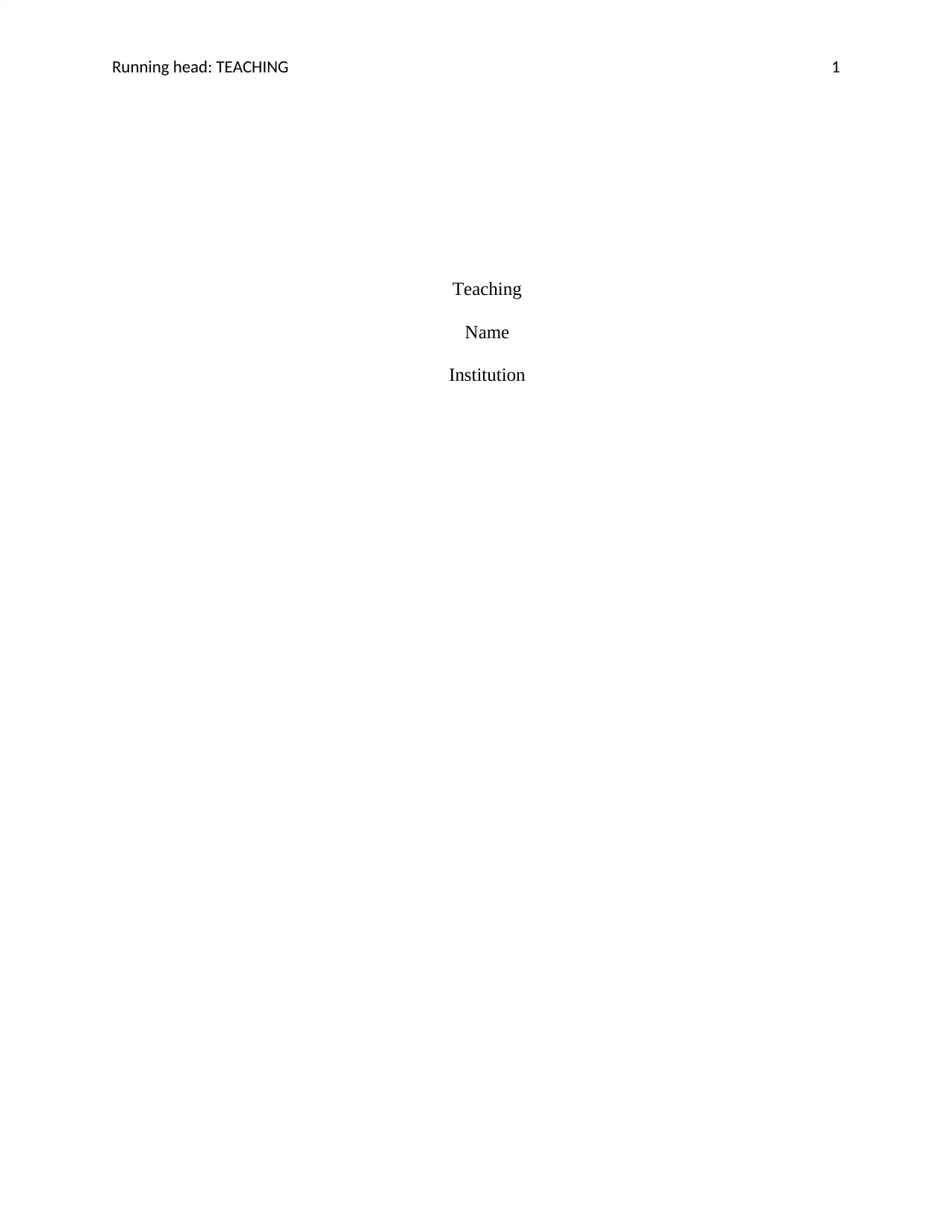
Running head: TEACHING 1
Teaching
Name
Institution
Teaching
Name
Institution
Paraphrase This Document
Need a fresh take? Get an instant paraphrase of this document with our AI Paraphraser
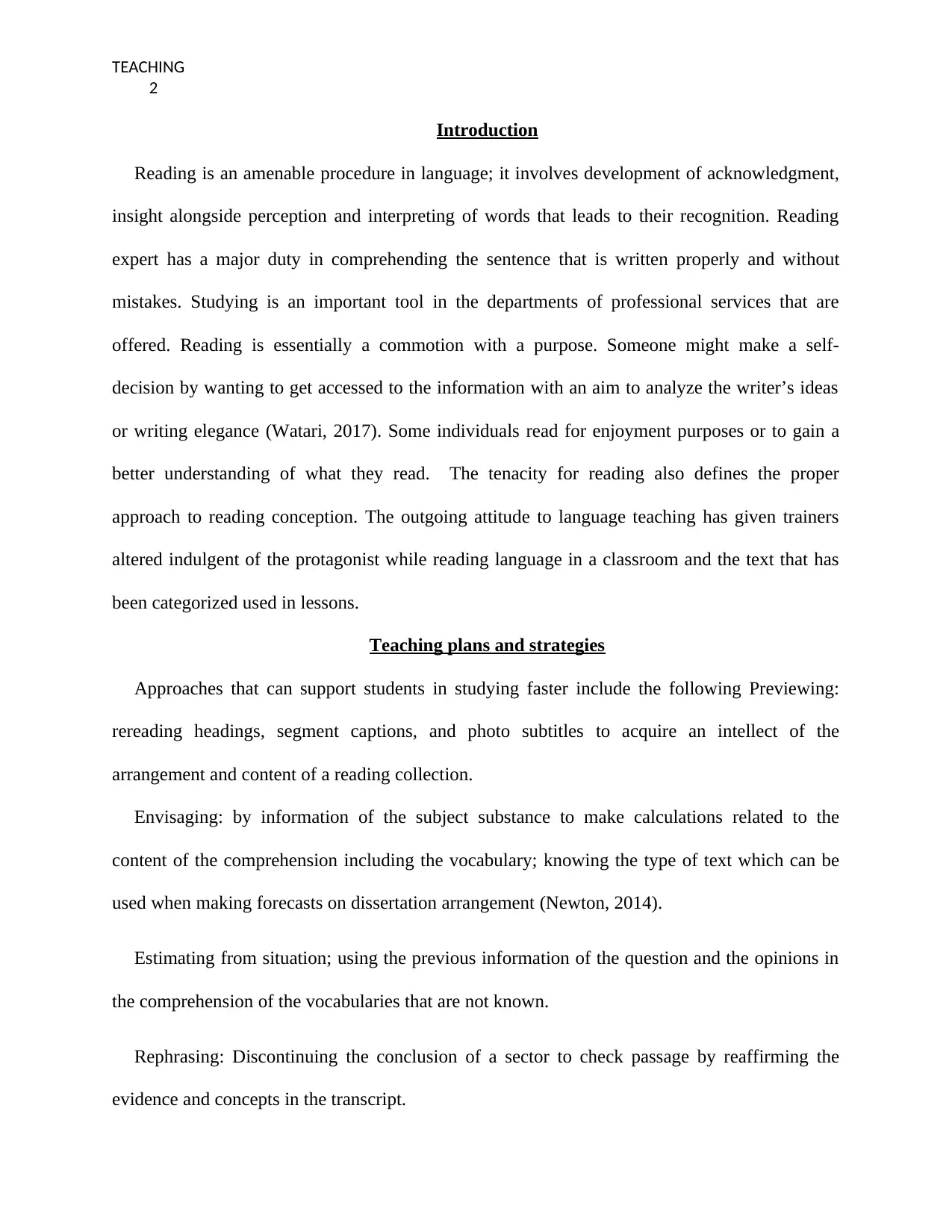
TEACHING
2
Introduction
Reading is an amenable procedure in language; it involves development of acknowledgment,
insight alongside perception and interpreting of words that leads to their recognition. Reading
expert has a major duty in comprehending the sentence that is written properly and without
mistakes. Studying is an important tool in the departments of professional services that are
offered. Reading is essentially a commotion with a purpose. Someone might make a self-
decision by wanting to get accessed to the information with an aim to analyze the writer’s ideas
or writing elegance (Watari, 2017). Some individuals read for enjoyment purposes or to gain a
better understanding of what they read. The tenacity for reading also defines the proper
approach to reading conception. The outgoing attitude to language teaching has given trainers
altered indulgent of the protagonist while reading language in a classroom and the text that has
been categorized used in lessons.
Teaching plans and strategies
Approaches that can support students in studying faster include the following Previewing:
rereading headings, segment captions, and photo subtitles to acquire an intellect of the
arrangement and content of a reading collection.
Envisaging: by information of the subject substance to make calculations related to the
content of the comprehension including the vocabulary; knowing the type of text which can be
used when making forecasts on dissertation arrangement (Newton, 2014).
Estimating from situation; using the previous information of the question and the opinions in
the comprehension of the vocabularies that are not known.
Rephrasing: Discontinuing the conclusion of a sector to check passage by reaffirming the
evidence and concepts in the transcript.
2
Introduction
Reading is an amenable procedure in language; it involves development of acknowledgment,
insight alongside perception and interpreting of words that leads to their recognition. Reading
expert has a major duty in comprehending the sentence that is written properly and without
mistakes. Studying is an important tool in the departments of professional services that are
offered. Reading is essentially a commotion with a purpose. Someone might make a self-
decision by wanting to get accessed to the information with an aim to analyze the writer’s ideas
or writing elegance (Watari, 2017). Some individuals read for enjoyment purposes or to gain a
better understanding of what they read. The tenacity for reading also defines the proper
approach to reading conception. The outgoing attitude to language teaching has given trainers
altered indulgent of the protagonist while reading language in a classroom and the text that has
been categorized used in lessons.
Teaching plans and strategies
Approaches that can support students in studying faster include the following Previewing:
rereading headings, segment captions, and photo subtitles to acquire an intellect of the
arrangement and content of a reading collection.
Envisaging: by information of the subject substance to make calculations related to the
content of the comprehension including the vocabulary; knowing the type of text which can be
used when making forecasts on dissertation arrangement (Newton, 2014).
Estimating from situation; using the previous information of the question and the opinions in
the comprehension of the vocabularies that are not known.
Rephrasing: Discontinuing the conclusion of a sector to check passage by reaffirming the
evidence and concepts in the transcript.
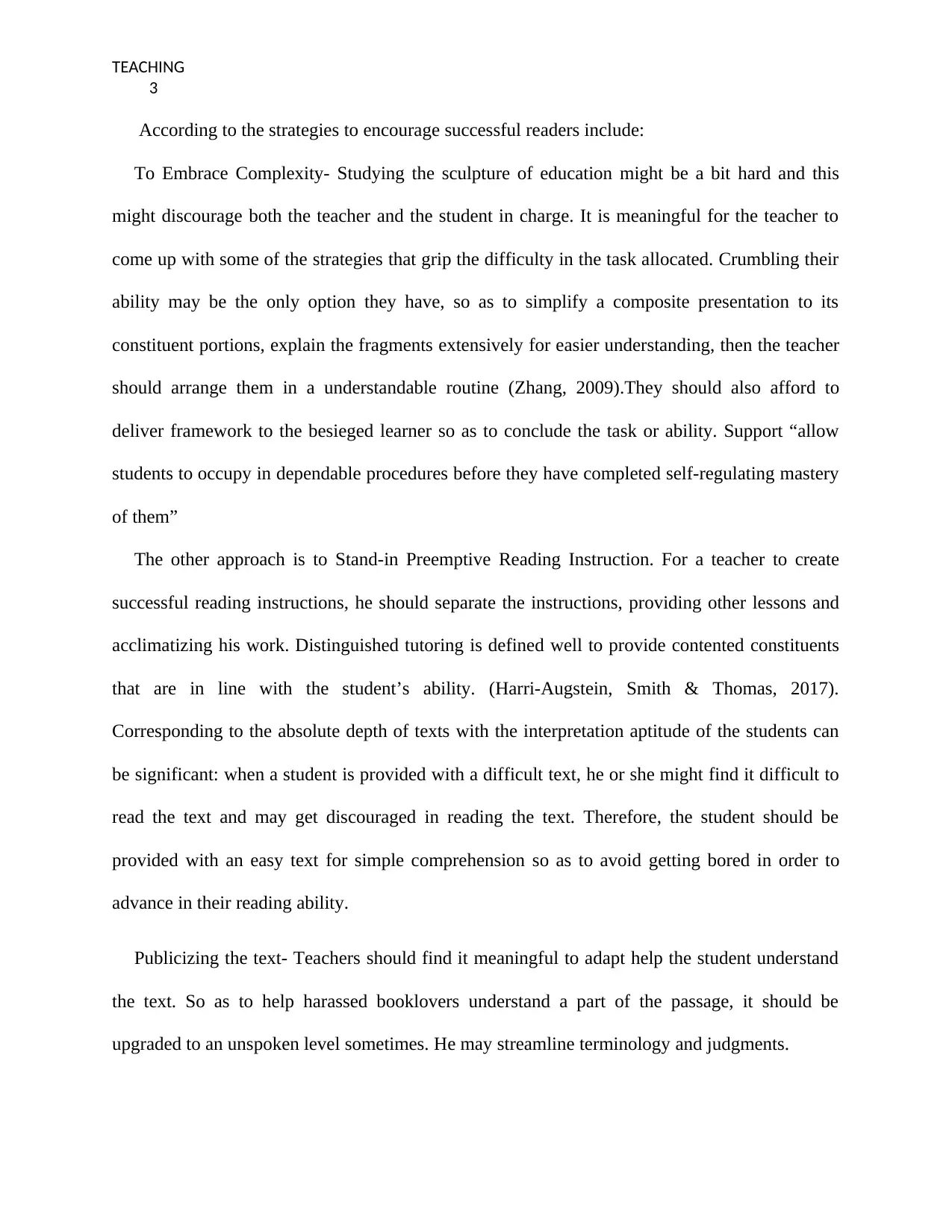
TEACHING
3
According to the strategies to encourage successful readers include:
To Embrace Complexity- Studying the sculpture of education might be a bit hard and this
might discourage both the teacher and the student in charge. It is meaningful for the teacher to
come up with some of the strategies that grip the difficulty in the task allocated. Crumbling their
ability may be the only option they have, so as to simplify a composite presentation to its
constituent portions, explain the fragments extensively for easier understanding, then the teacher
should arrange them in a understandable routine (Zhang, 2009).They should also afford to
deliver framework to the besieged learner so as to conclude the task or ability. Support “allow
students to occupy in dependable procedures before they have completed self-regulating mastery
of them”
The other approach is to Stand-in Preemptive Reading Instruction. For a teacher to create
successful reading instructions, he should separate the instructions, providing other lessons and
acclimatizing his work. Distinguished tutoring is defined well to provide contented constituents
that are in line with the student’s ability. (Harri-Augstein, Smith & Thomas, 2017).
Corresponding to the absolute depth of texts with the interpretation aptitude of the students can
be significant: when a student is provided with a difficult text, he or she might find it difficult to
read the text and may get discouraged in reading the text. Therefore, the student should be
provided with an easy text for simple comprehension so as to avoid getting bored in order to
advance in their reading ability.
Publicizing the text- Teachers should find it meaningful to adapt help the student understand
the text. So as to help harassed booklovers understand a part of the passage, it should be
upgraded to an unspoken level sometimes. He may streamline terminology and judgments.
3
According to the strategies to encourage successful readers include:
To Embrace Complexity- Studying the sculpture of education might be a bit hard and this
might discourage both the teacher and the student in charge. It is meaningful for the teacher to
come up with some of the strategies that grip the difficulty in the task allocated. Crumbling their
ability may be the only option they have, so as to simplify a composite presentation to its
constituent portions, explain the fragments extensively for easier understanding, then the teacher
should arrange them in a understandable routine (Zhang, 2009).They should also afford to
deliver framework to the besieged learner so as to conclude the task or ability. Support “allow
students to occupy in dependable procedures before they have completed self-regulating mastery
of them”
The other approach is to Stand-in Preemptive Reading Instruction. For a teacher to create
successful reading instructions, he should separate the instructions, providing other lessons and
acclimatizing his work. Distinguished tutoring is defined well to provide contented constituents
that are in line with the student’s ability. (Harri-Augstein, Smith & Thomas, 2017).
Corresponding to the absolute depth of texts with the interpretation aptitude of the students can
be significant: when a student is provided with a difficult text, he or she might find it difficult to
read the text and may get discouraged in reading the text. Therefore, the student should be
provided with an easy text for simple comprehension so as to avoid getting bored in order to
advance in their reading ability.
Publicizing the text- Teachers should find it meaningful to adapt help the student understand
the text. So as to help harassed booklovers understand a part of the passage, it should be
upgraded to an unspoken level sometimes. He may streamline terminology and judgments.
⊘ This is a preview!⊘
Do you want full access?
Subscribe today to unlock all pages.

Trusted by 1+ million students worldwide
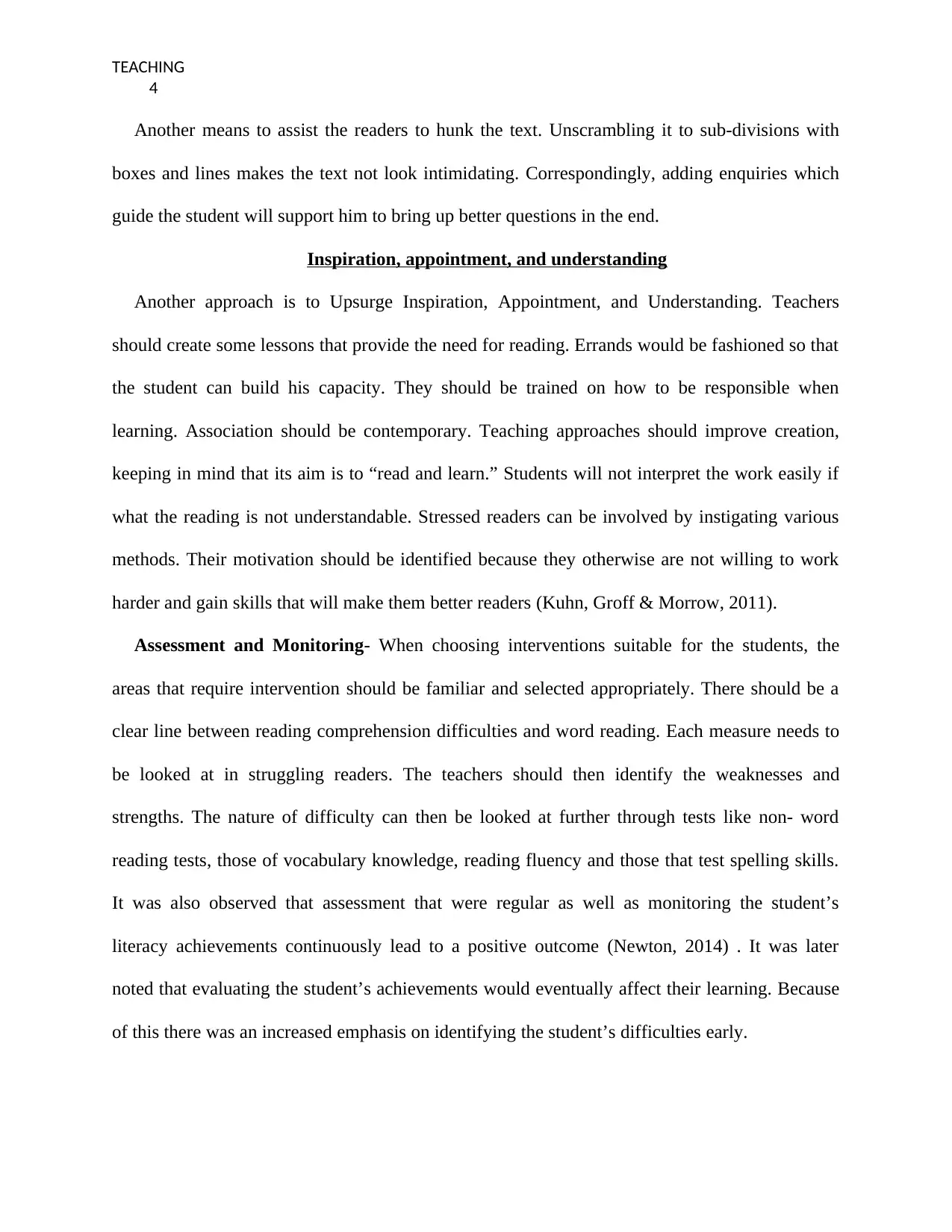
TEACHING
4
Another means to assist the readers to hunk the text. Unscrambling it to sub-divisions with
boxes and lines makes the text not look intimidating. Correspondingly, adding enquiries which
guide the student will support him to bring up better questions in the end.
Inspiration, appointment, and understanding
Another approach is to Upsurge Inspiration, Appointment, and Understanding. Teachers
should create some lessons that provide the need for reading. Errands would be fashioned so that
the student can build his capacity. They should be trained on how to be responsible when
learning. Association should be contemporary. Teaching approaches should improve creation,
keeping in mind that its aim is to “read and learn.” Students will not interpret the work easily if
what the reading is not understandable. Stressed readers can be involved by instigating various
methods. Their motivation should be identified because they otherwise are not willing to work
harder and gain skills that will make them better readers (Kuhn, Groff & Morrow, 2011).
Assessment and Monitoring- When choosing interventions suitable for the students, the
areas that require intervention should be familiar and selected appropriately. There should be a
clear line between reading comprehension difficulties and word reading. Each measure needs to
be looked at in struggling readers. The teachers should then identify the weaknesses and
strengths. The nature of difficulty can then be looked at further through tests like non- word
reading tests, those of vocabulary knowledge, reading fluency and those that test spelling skills.
It was also observed that assessment that were regular as well as monitoring the student’s
literacy achievements continuously lead to a positive outcome (Newton, 2014) . It was later
noted that evaluating the student’s achievements would eventually affect their learning. Because
of this there was an increased emphasis on identifying the student’s difficulties early.
4
Another means to assist the readers to hunk the text. Unscrambling it to sub-divisions with
boxes and lines makes the text not look intimidating. Correspondingly, adding enquiries which
guide the student will support him to bring up better questions in the end.
Inspiration, appointment, and understanding
Another approach is to Upsurge Inspiration, Appointment, and Understanding. Teachers
should create some lessons that provide the need for reading. Errands would be fashioned so that
the student can build his capacity. They should be trained on how to be responsible when
learning. Association should be contemporary. Teaching approaches should improve creation,
keeping in mind that its aim is to “read and learn.” Students will not interpret the work easily if
what the reading is not understandable. Stressed readers can be involved by instigating various
methods. Their motivation should be identified because they otherwise are not willing to work
harder and gain skills that will make them better readers (Kuhn, Groff & Morrow, 2011).
Assessment and Monitoring- When choosing interventions suitable for the students, the
areas that require intervention should be familiar and selected appropriately. There should be a
clear line between reading comprehension difficulties and word reading. Each measure needs to
be looked at in struggling readers. The teachers should then identify the weaknesses and
strengths. The nature of difficulty can then be looked at further through tests like non- word
reading tests, those of vocabulary knowledge, reading fluency and those that test spelling skills.
It was also observed that assessment that were regular as well as monitoring the student’s
literacy achievements continuously lead to a positive outcome (Newton, 2014) . It was later
noted that evaluating the student’s achievements would eventually affect their learning. Because
of this there was an increased emphasis on identifying the student’s difficulties early.
Paraphrase This Document
Need a fresh take? Get an instant paraphrase of this document with our AI Paraphraser
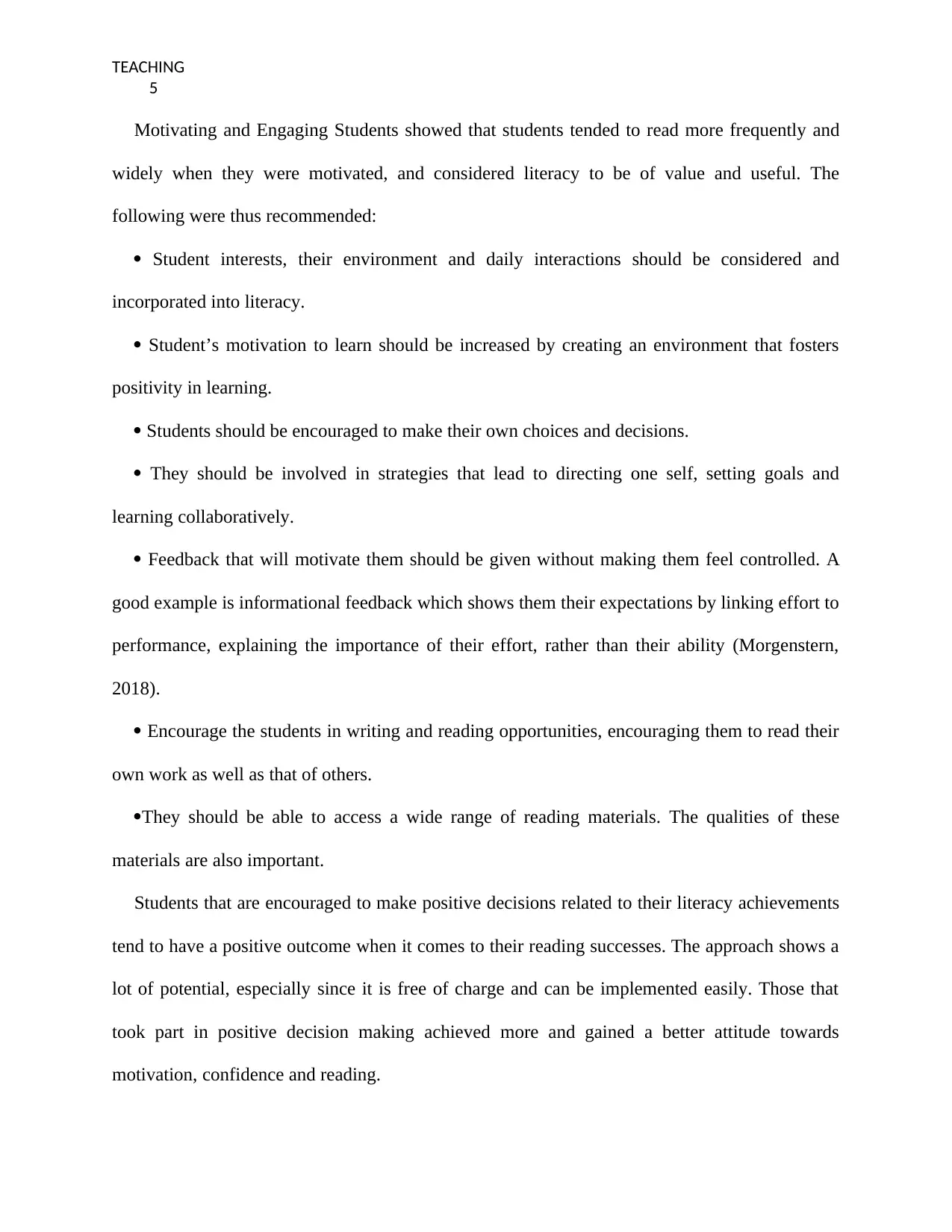
TEACHING
5
Motivating and Engaging Students showed that students tended to read more frequently and
widely when they were motivated, and considered literacy to be of value and useful. The
following were thus recommended:
Student interests, their environment and daily interactions should be considered and
incorporated into literacy.
Student’s motivation to learn should be increased by creating an environment that fosters
positivity in learning.
Students should be encouraged to make their own choices and decisions.
They should be involved in strategies that lead to directing one self, setting goals and
learning collaboratively.
Feedback that will motivate them should be given without making them feel controlled. A
good example is informational feedback which shows them their expectations by linking effort to
performance, explaining the importance of their effort, rather than their ability (Morgenstern,
2018).
Encourage the students in writing and reading opportunities, encouraging them to read their
own work as well as that of others.
They should be able to access a wide range of reading materials. The qualities of these
materials are also important.
Students that are encouraged to make positive decisions related to their literacy achievements
tend to have a positive outcome when it comes to their reading successes. The approach shows a
lot of potential, especially since it is free of charge and can be implemented easily. Those that
took part in positive decision making achieved more and gained a better attitude towards
motivation, confidence and reading.
5
Motivating and Engaging Students showed that students tended to read more frequently and
widely when they were motivated, and considered literacy to be of value and useful. The
following were thus recommended:
Student interests, their environment and daily interactions should be considered and
incorporated into literacy.
Student’s motivation to learn should be increased by creating an environment that fosters
positivity in learning.
Students should be encouraged to make their own choices and decisions.
They should be involved in strategies that lead to directing one self, setting goals and
learning collaboratively.
Feedback that will motivate them should be given without making them feel controlled. A
good example is informational feedback which shows them their expectations by linking effort to
performance, explaining the importance of their effort, rather than their ability (Morgenstern,
2018).
Encourage the students in writing and reading opportunities, encouraging them to read their
own work as well as that of others.
They should be able to access a wide range of reading materials. The qualities of these
materials are also important.
Students that are encouraged to make positive decisions related to their literacy achievements
tend to have a positive outcome when it comes to their reading successes. The approach shows a
lot of potential, especially since it is free of charge and can be implemented easily. Those that
took part in positive decision making achieved more and gained a better attitude towards
motivation, confidence and reading.
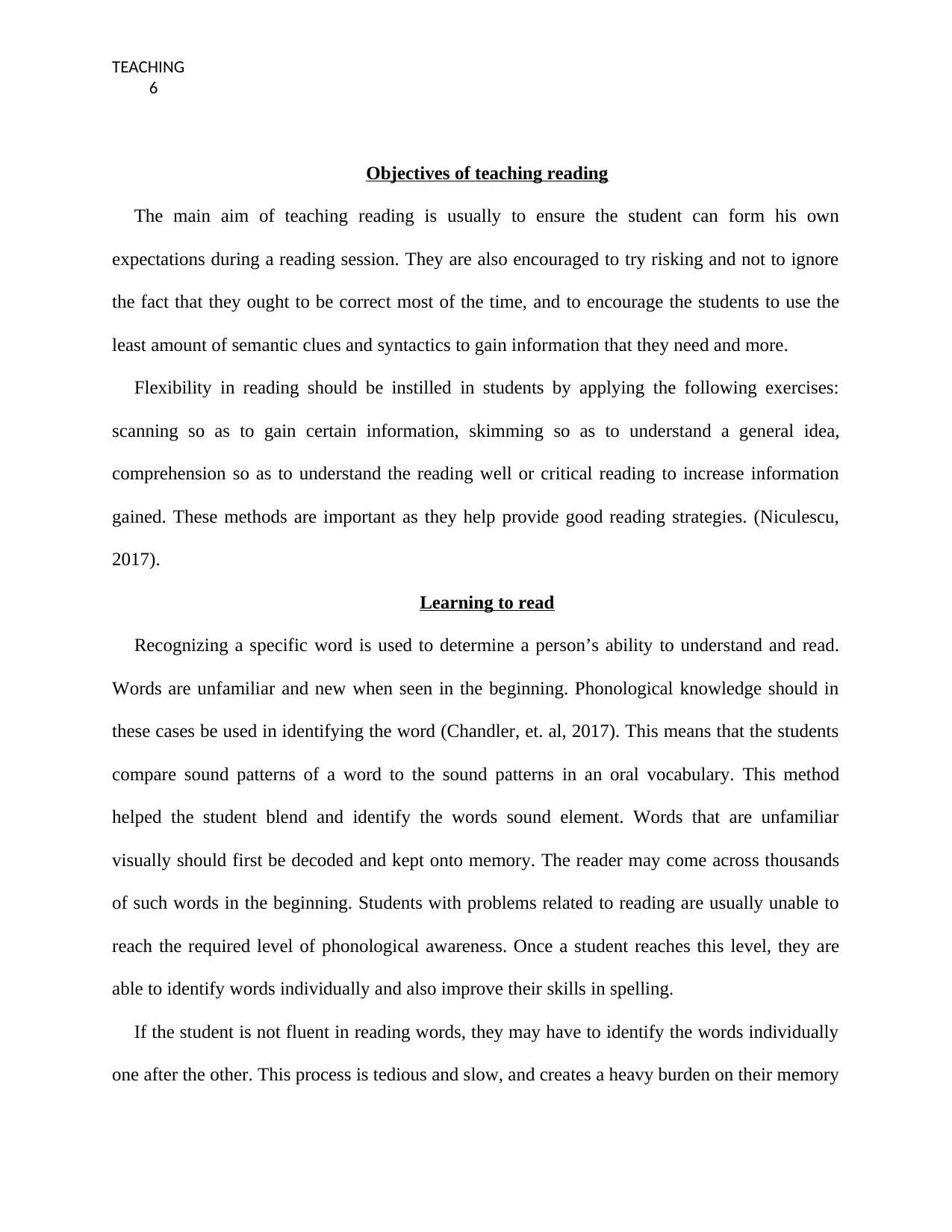
TEACHING
6
Objectives of teaching reading
The main aim of teaching reading is usually to ensure the student can form his own
expectations during a reading session. They are also encouraged to try risking and not to ignore
the fact that they ought to be correct most of the time, and to encourage the students to use the
least amount of semantic clues and syntactics to gain information that they need and more.
Flexibility in reading should be instilled in students by applying the following exercises:
scanning so as to gain certain information, skimming so as to understand a general idea,
comprehension so as to understand the reading well or critical reading to increase information
gained. These methods are important as they help provide good reading strategies. (Niculescu,
2017).
Learning to read
Recognizing a specific word is used to determine a person’s ability to understand and read.
Words are unfamiliar and new when seen in the beginning. Phonological knowledge should in
these cases be used in identifying the word (Chandler, et. al, 2017). This means that the students
compare sound patterns of a word to the sound patterns in an oral vocabulary. This method
helped the student blend and identify the words sound element. Words that are unfamiliar
visually should first be decoded and kept onto memory. The reader may come across thousands
of such words in the beginning. Students with problems related to reading are usually unable to
reach the required level of phonological awareness. Once a student reaches this level, they are
able to identify words individually and also improve their skills in spelling.
If the student is not fluent in reading words, they may have to identify the words individually
one after the other. This process is tedious and slow, and creates a heavy burden on their memory
6
Objectives of teaching reading
The main aim of teaching reading is usually to ensure the student can form his own
expectations during a reading session. They are also encouraged to try risking and not to ignore
the fact that they ought to be correct most of the time, and to encourage the students to use the
least amount of semantic clues and syntactics to gain information that they need and more.
Flexibility in reading should be instilled in students by applying the following exercises:
scanning so as to gain certain information, skimming so as to understand a general idea,
comprehension so as to understand the reading well or critical reading to increase information
gained. These methods are important as they help provide good reading strategies. (Niculescu,
2017).
Learning to read
Recognizing a specific word is used to determine a person’s ability to understand and read.
Words are unfamiliar and new when seen in the beginning. Phonological knowledge should in
these cases be used in identifying the word (Chandler, et. al, 2017). This means that the students
compare sound patterns of a word to the sound patterns in an oral vocabulary. This method
helped the student blend and identify the words sound element. Words that are unfamiliar
visually should first be decoded and kept onto memory. The reader may come across thousands
of such words in the beginning. Students with problems related to reading are usually unable to
reach the required level of phonological awareness. Once a student reaches this level, they are
able to identify words individually and also improve their skills in spelling.
If the student is not fluent in reading words, they may have to identify the words individually
one after the other. This process is tedious and slow, and creates a heavy burden on their memory
⊘ This is a preview!⊘
Do you want full access?
Subscribe today to unlock all pages.

Trusted by 1+ million students worldwide
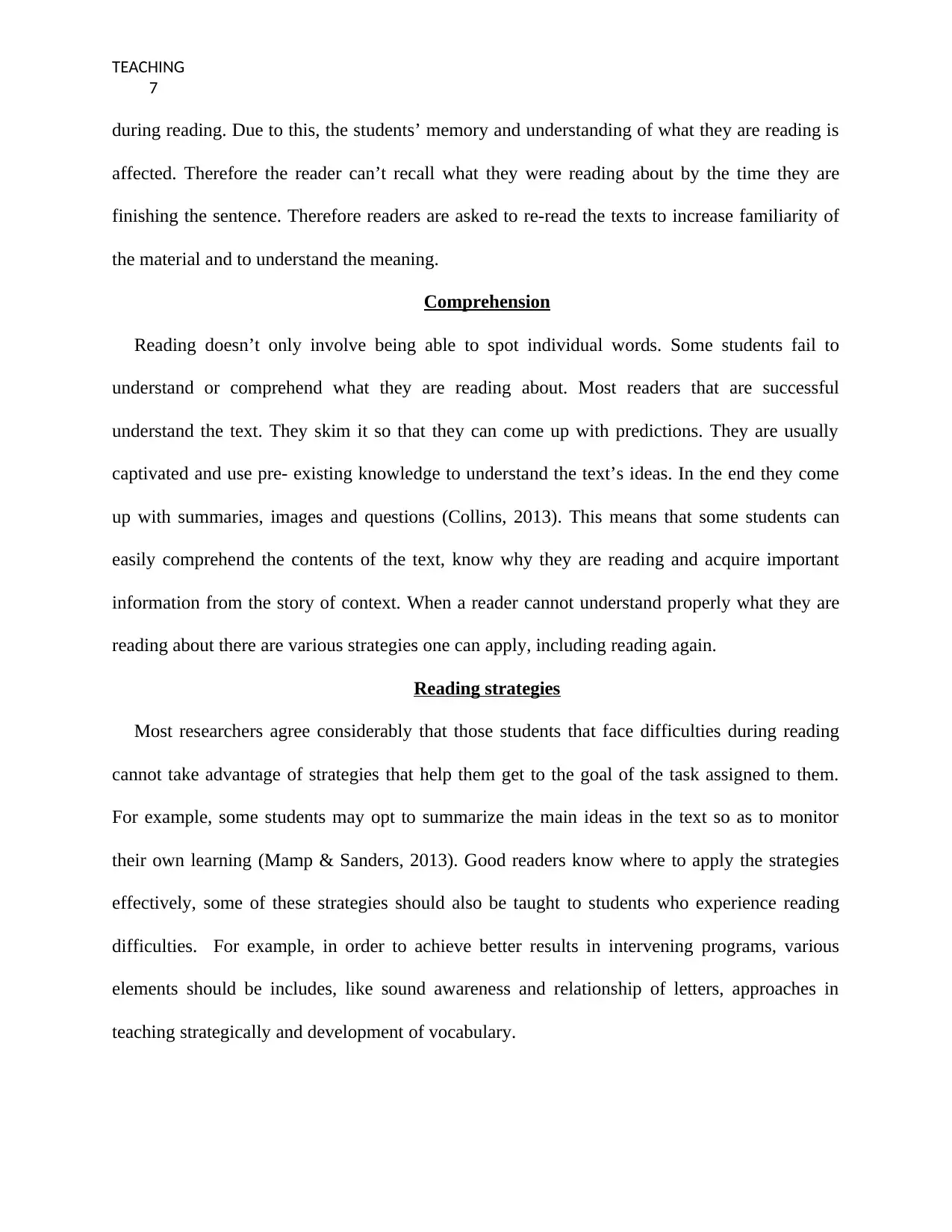
TEACHING
7
during reading. Due to this, the students’ memory and understanding of what they are reading is
affected. Therefore the reader can’t recall what they were reading about by the time they are
finishing the sentence. Therefore readers are asked to re-read the texts to increase familiarity of
the material and to understand the meaning.
Comprehension
Reading doesn’t only involve being able to spot individual words. Some students fail to
understand or comprehend what they are reading about. Most readers that are successful
understand the text. They skim it so that they can come up with predictions. They are usually
captivated and use pre- existing knowledge to understand the text’s ideas. In the end they come
up with summaries, images and questions (Collins, 2013). This means that some students can
easily comprehend the contents of the text, know why they are reading and acquire important
information from the story of context. When a reader cannot understand properly what they are
reading about there are various strategies one can apply, including reading again.
Reading strategies
Most researchers agree considerably that those students that face difficulties during reading
cannot take advantage of strategies that help them get to the goal of the task assigned to them.
For example, some students may opt to summarize the main ideas in the text so as to monitor
their own learning (Mamp & Sanders, 2013). Good readers know where to apply the strategies
effectively, some of these strategies should also be taught to students who experience reading
difficulties. For example, in order to achieve better results in intervening programs, various
elements should be includes, like sound awareness and relationship of letters, approaches in
teaching strategically and development of vocabulary.
7
during reading. Due to this, the students’ memory and understanding of what they are reading is
affected. Therefore the reader can’t recall what they were reading about by the time they are
finishing the sentence. Therefore readers are asked to re-read the texts to increase familiarity of
the material and to understand the meaning.
Comprehension
Reading doesn’t only involve being able to spot individual words. Some students fail to
understand or comprehend what they are reading about. Most readers that are successful
understand the text. They skim it so that they can come up with predictions. They are usually
captivated and use pre- existing knowledge to understand the text’s ideas. In the end they come
up with summaries, images and questions (Collins, 2013). This means that some students can
easily comprehend the contents of the text, know why they are reading and acquire important
information from the story of context. When a reader cannot understand properly what they are
reading about there are various strategies one can apply, including reading again.
Reading strategies
Most researchers agree considerably that those students that face difficulties during reading
cannot take advantage of strategies that help them get to the goal of the task assigned to them.
For example, some students may opt to summarize the main ideas in the text so as to monitor
their own learning (Mamp & Sanders, 2013). Good readers know where to apply the strategies
effectively, some of these strategies should also be taught to students who experience reading
difficulties. For example, in order to achieve better results in intervening programs, various
elements should be includes, like sound awareness and relationship of letters, approaches in
teaching strategically and development of vocabulary.
Paraphrase This Document
Need a fresh take? Get an instant paraphrase of this document with our AI Paraphraser
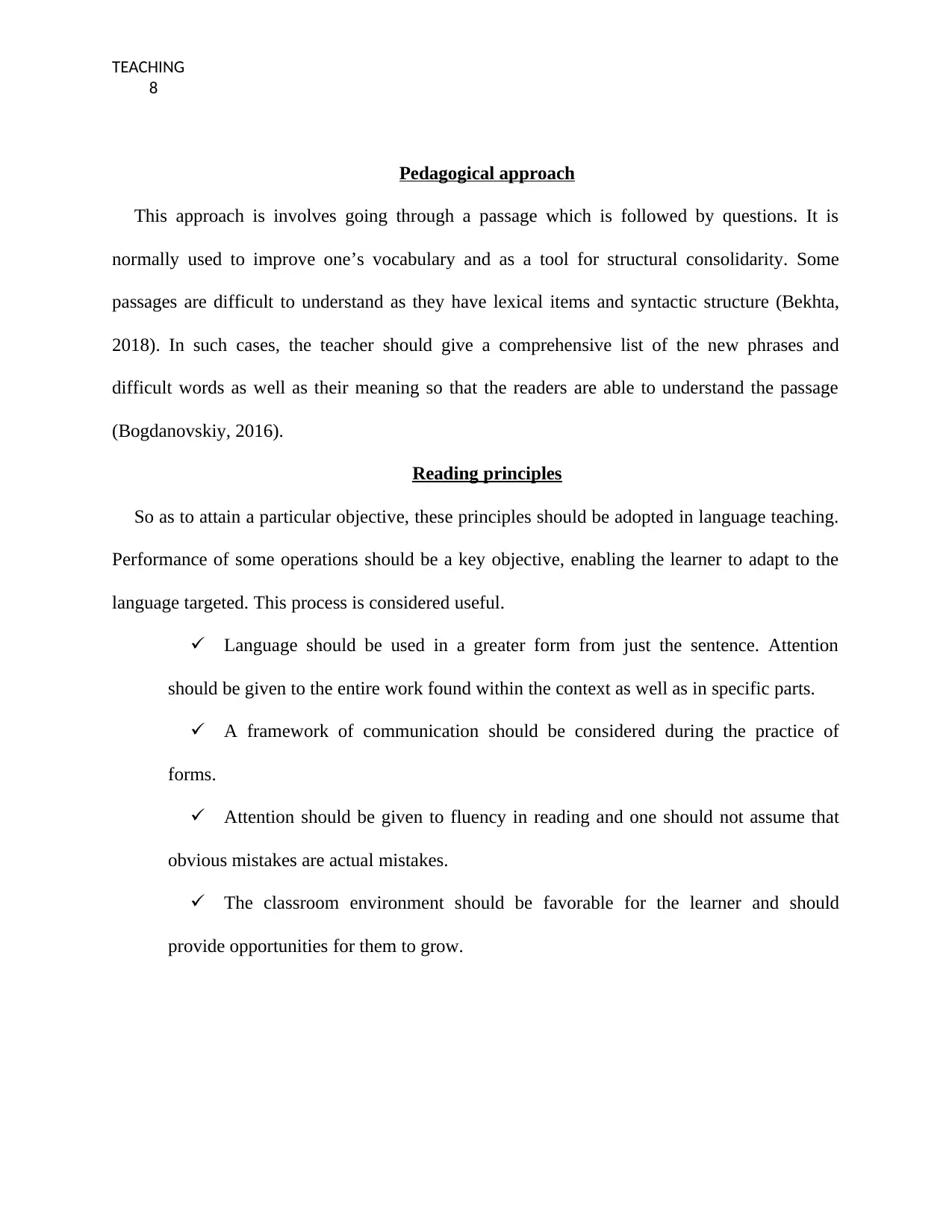
TEACHING
8
Pedagogical approach
This approach is involves going through a passage which is followed by questions. It is
normally used to improve one’s vocabulary and as a tool for structural consolidarity. Some
passages are difficult to understand as they have lexical items and syntactic structure (Bekhta,
2018). In such cases, the teacher should give a comprehensive list of the new phrases and
difficult words as well as their meaning so that the readers are able to understand the passage
(Bogdanovskiy, 2016).
Reading principles
So as to attain a particular objective, these principles should be adopted in language teaching.
Performance of some operations should be a key objective, enabling the learner to adapt to the
language targeted. This process is considered useful.
Language should be used in a greater form from just the sentence. Attention
should be given to the entire work found within the context as well as in specific parts.
A framework of communication should be considered during the practice of
forms.
Attention should be given to fluency in reading and one should not assume that
obvious mistakes are actual mistakes.
The classroom environment should be favorable for the learner and should
provide opportunities for them to grow.
8
Pedagogical approach
This approach is involves going through a passage which is followed by questions. It is
normally used to improve one’s vocabulary and as a tool for structural consolidarity. Some
passages are difficult to understand as they have lexical items and syntactic structure (Bekhta,
2018). In such cases, the teacher should give a comprehensive list of the new phrases and
difficult words as well as their meaning so that the readers are able to understand the passage
(Bogdanovskiy, 2016).
Reading principles
So as to attain a particular objective, these principles should be adopted in language teaching.
Performance of some operations should be a key objective, enabling the learner to adapt to the
language targeted. This process is considered useful.
Language should be used in a greater form from just the sentence. Attention
should be given to the entire work found within the context as well as in specific parts.
A framework of communication should be considered during the practice of
forms.
Attention should be given to fluency in reading and one should not assume that
obvious mistakes are actual mistakes.
The classroom environment should be favorable for the learner and should
provide opportunities for them to grow.
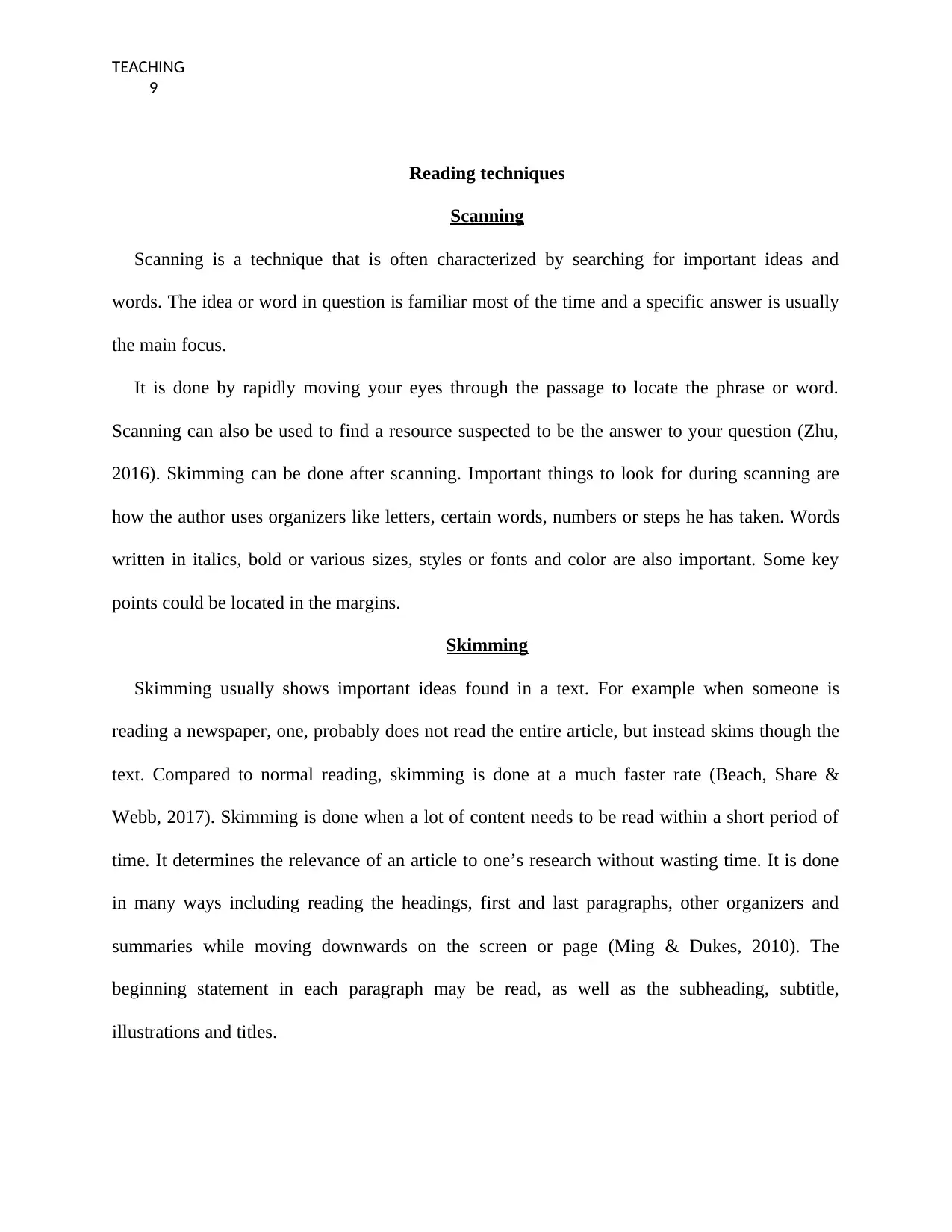
TEACHING
9
Reading techniques
Scanning
Scanning is a technique that is often characterized by searching for important ideas and
words. The idea or word in question is familiar most of the time and a specific answer is usually
the main focus.
It is done by rapidly moving your eyes through the passage to locate the phrase or word.
Scanning can also be used to find a resource suspected to be the answer to your question (Zhu,
2016). Skimming can be done after scanning. Important things to look for during scanning are
how the author uses organizers like letters, certain words, numbers or steps he has taken. Words
written in italics, bold or various sizes, styles or fonts and color are also important. Some key
points could be located in the margins.
Skimming
Skimming usually shows important ideas found in a text. For example when someone is
reading a newspaper, one, probably does not read the entire article, but instead skims though the
text. Compared to normal reading, skimming is done at a much faster rate (Beach, Share &
Webb, 2017). Skimming is done when a lot of content needs to be read within a short period of
time. It determines the relevance of an article to one’s research without wasting time. It is done
in many ways including reading the headings, first and last paragraphs, other organizers and
summaries while moving downwards on the screen or page (Ming & Dukes, 2010). The
beginning statement in each paragraph may be read, as well as the subheading, subtitle,
illustrations and titles.
9
Reading techniques
Scanning
Scanning is a technique that is often characterized by searching for important ideas and
words. The idea or word in question is familiar most of the time and a specific answer is usually
the main focus.
It is done by rapidly moving your eyes through the passage to locate the phrase or word.
Scanning can also be used to find a resource suspected to be the answer to your question (Zhu,
2016). Skimming can be done after scanning. Important things to look for during scanning are
how the author uses organizers like letters, certain words, numbers or steps he has taken. Words
written in italics, bold or various sizes, styles or fonts and color are also important. Some key
points could be located in the margins.
Skimming
Skimming usually shows important ideas found in a text. For example when someone is
reading a newspaper, one, probably does not read the entire article, but instead skims though the
text. Compared to normal reading, skimming is done at a much faster rate (Beach, Share &
Webb, 2017). Skimming is done when a lot of content needs to be read within a short period of
time. It determines the relevance of an article to one’s research without wasting time. It is done
in many ways including reading the headings, first and last paragraphs, other organizers and
summaries while moving downwards on the screen or page (Ming & Dukes, 2010). The
beginning statement in each paragraph may be read, as well as the subheading, subtitle,
illustrations and titles.
⊘ This is a preview!⊘
Do you want full access?
Subscribe today to unlock all pages.

Trusted by 1+ million students worldwide
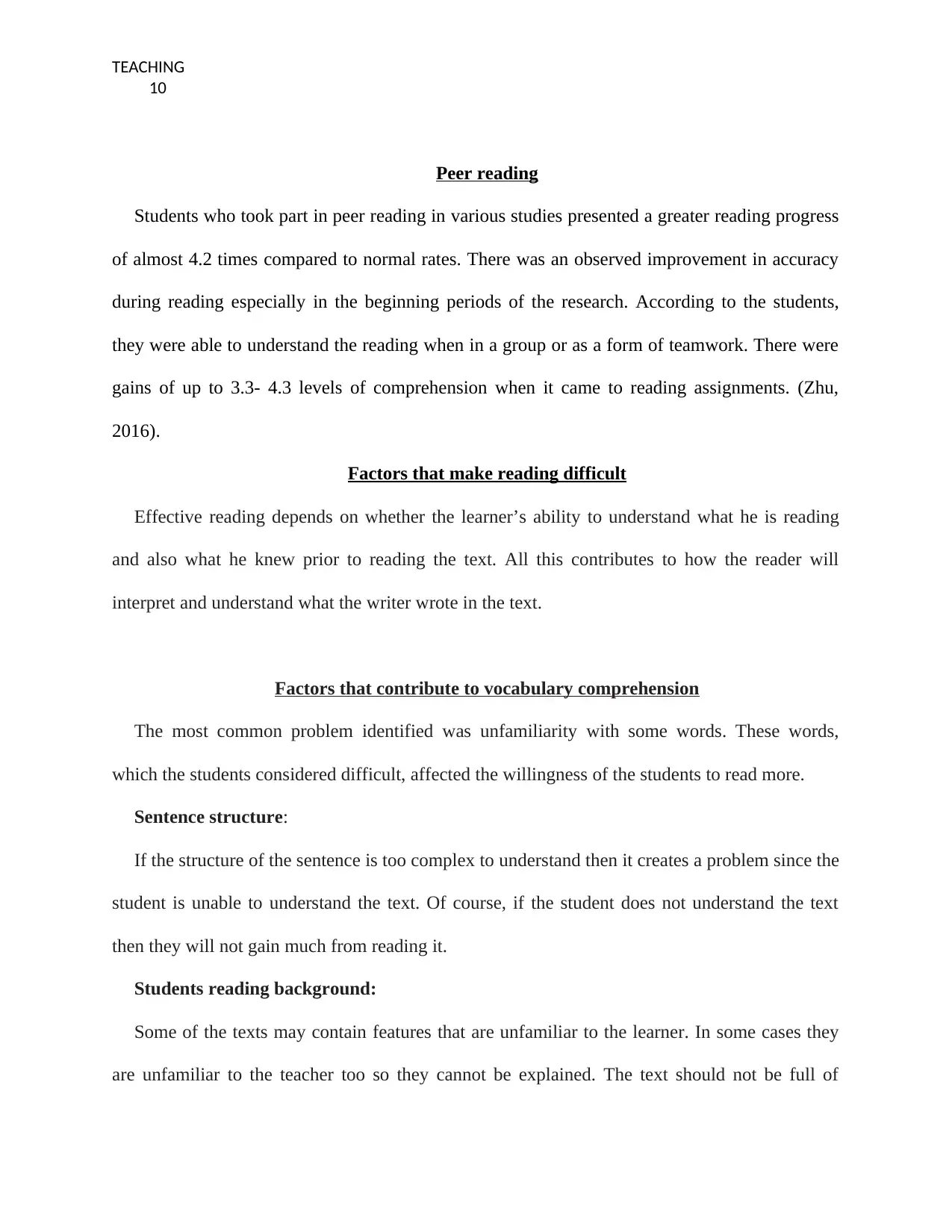
TEACHING
10
Peer reading
Students who took part in peer reading in various studies presented a greater reading progress
of almost 4.2 times compared to normal rates. There was an observed improvement in accuracy
during reading especially in the beginning periods of the research. According to the students,
they were able to understand the reading when in a group or as a form of teamwork. There were
gains of up to 3.3- 4.3 levels of comprehension when it came to reading assignments. (Zhu,
2016).
Factors that make reading difficult
Effective reading depends on whether the learner’s ability to understand what he is reading
and also what he knew prior to reading the text. All this contributes to how the reader will
interpret and understand what the writer wrote in the text.
Factors that contribute to vocabulary comprehension
The most common problem identified was unfamiliarity with some words. These words,
which the students considered difficult, affected the willingness of the students to read more.
Sentence structure:
If the structure of the sentence is too complex to understand then it creates a problem since the
student is unable to understand the text. Of course, if the student does not understand the text
then they will not gain much from reading it.
Students reading background:
Some of the texts may contain features that are unfamiliar to the learner. In some cases they
are unfamiliar to the teacher too so they cannot be explained. The text should not be full of
10
Peer reading
Students who took part in peer reading in various studies presented a greater reading progress
of almost 4.2 times compared to normal rates. There was an observed improvement in accuracy
during reading especially in the beginning periods of the research. According to the students,
they were able to understand the reading when in a group or as a form of teamwork. There were
gains of up to 3.3- 4.3 levels of comprehension when it came to reading assignments. (Zhu,
2016).
Factors that make reading difficult
Effective reading depends on whether the learner’s ability to understand what he is reading
and also what he knew prior to reading the text. All this contributes to how the reader will
interpret and understand what the writer wrote in the text.
Factors that contribute to vocabulary comprehension
The most common problem identified was unfamiliarity with some words. These words,
which the students considered difficult, affected the willingness of the students to read more.
Sentence structure:
If the structure of the sentence is too complex to understand then it creates a problem since the
student is unable to understand the text. Of course, if the student does not understand the text
then they will not gain much from reading it.
Students reading background:
Some of the texts may contain features that are unfamiliar to the learner. In some cases they
are unfamiliar to the teacher too so they cannot be explained. The text should not be full of
Paraphrase This Document
Need a fresh take? Get an instant paraphrase of this document with our AI Paraphraser
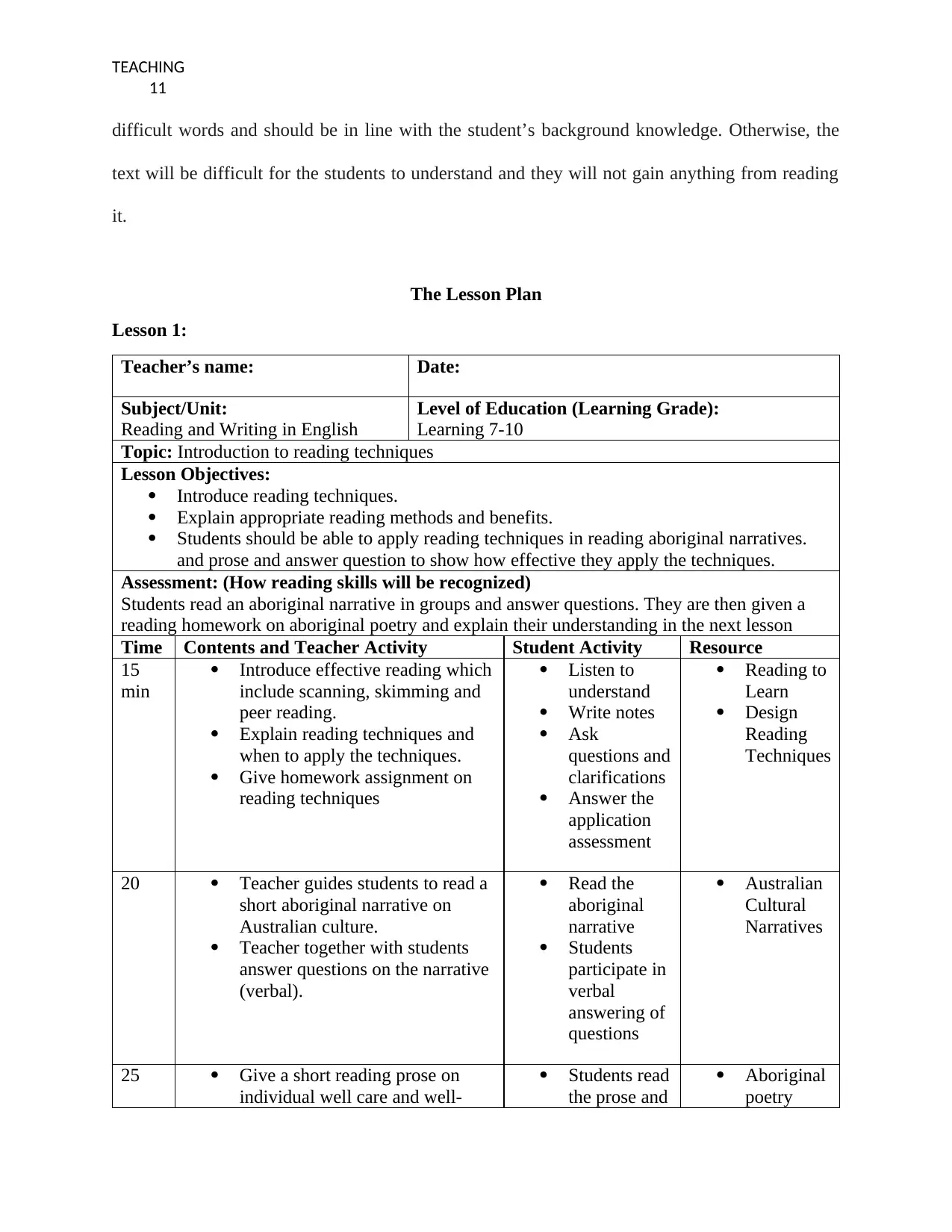
TEACHING
11
difficult words and should be in line with the student’s background knowledge. Otherwise, the
text will be difficult for the students to understand and they will not gain anything from reading
it.
The Lesson Plan
Lesson 1:
Teacher’s name: Date:
Subject/Unit:
Reading and Writing in English
Level of Education (Learning Grade):
Learning 7-10
Topic: Introduction to reading techniques
Lesson Objectives:
Introduce reading techniques.
Explain appropriate reading methods and benefits.
Students should be able to apply reading techniques in reading aboriginal narratives.
and prose and answer question to show how effective they apply the techniques.
Assessment: (How reading skills will be recognized)
Students read an aboriginal narrative in groups and answer questions. They are then given a
reading homework on aboriginal poetry and explain their understanding in the next lesson
Time Contents and Teacher Activity Student Activity Resource
15
min
Introduce effective reading which
include scanning, skimming and
peer reading.
Explain reading techniques and
when to apply the techniques.
Give homework assignment on
reading techniques
Listen to
understand
Write notes
Ask
questions and
clarifications
Answer the
application
assessment
Reading to
Learn
Design
Reading
Techniques
20 Teacher guides students to read a
short aboriginal narrative on
Australian culture.
Teacher together with students
answer questions on the narrative
(verbal).
Read the
aboriginal
narrative
Students
participate in
verbal
answering of
questions
Australian
Cultural
Narratives
25 Give a short reading prose on
individual well care and well-
Students read
the prose and
Aboriginal
poetry
11
difficult words and should be in line with the student’s background knowledge. Otherwise, the
text will be difficult for the students to understand and they will not gain anything from reading
it.
The Lesson Plan
Lesson 1:
Teacher’s name: Date:
Subject/Unit:
Reading and Writing in English
Level of Education (Learning Grade):
Learning 7-10
Topic: Introduction to reading techniques
Lesson Objectives:
Introduce reading techniques.
Explain appropriate reading methods and benefits.
Students should be able to apply reading techniques in reading aboriginal narratives.
and prose and answer question to show how effective they apply the techniques.
Assessment: (How reading skills will be recognized)
Students read an aboriginal narrative in groups and answer questions. They are then given a
reading homework on aboriginal poetry and explain their understanding in the next lesson
Time Contents and Teacher Activity Student Activity Resource
15
min
Introduce effective reading which
include scanning, skimming and
peer reading.
Explain reading techniques and
when to apply the techniques.
Give homework assignment on
reading techniques
Listen to
understand
Write notes
Ask
questions and
clarifications
Answer the
application
assessment
Reading to
Learn
Design
Reading
Techniques
20 Teacher guides students to read a
short aboriginal narrative on
Australian culture.
Teacher together with students
answer questions on the narrative
(verbal).
Read the
aboriginal
narrative
Students
participate in
verbal
answering of
questions
Australian
Cultural
Narratives
25 Give a short reading prose on
individual well care and well-
Students read
the prose and
Aboriginal
poetry
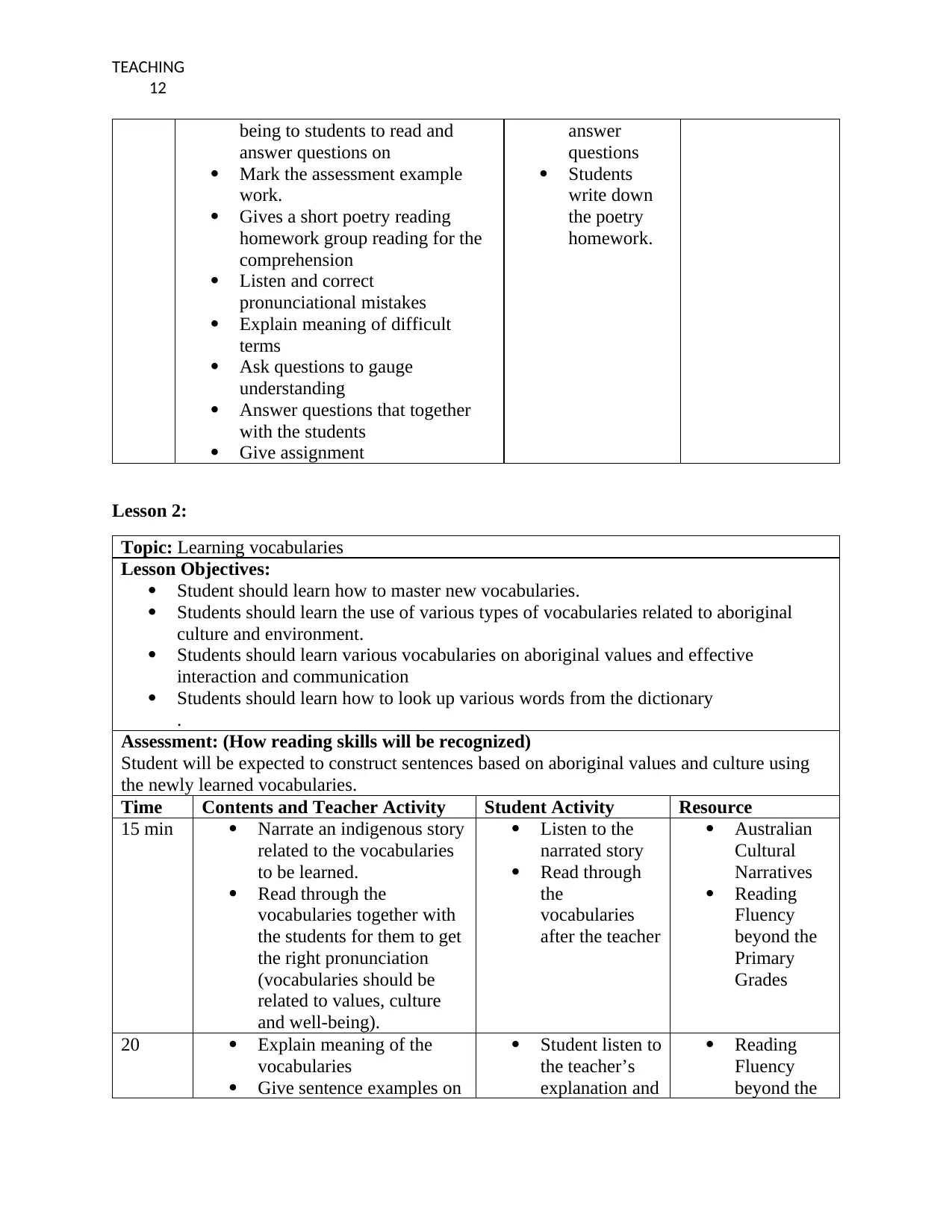
TEACHING
12
being to students to read and
answer questions on
Mark the assessment example
work.
Gives a short poetry reading
homework group reading for the
comprehension
Listen and correct
pronunciational mistakes
Explain meaning of difficult
terms
Ask questions to gauge
understanding
Answer questions that together
with the students
Give assignment
answer
questions
Students
write down
the poetry
homework.
Lesson 2:
Topic: Learning vocabularies
Lesson Objectives:
Student should learn how to master new vocabularies.
Students should learn the use of various types of vocabularies related to aboriginal
culture and environment.
Students should learn various vocabularies on aboriginal values and effective
interaction and communication
Students should learn how to look up various words from the dictionary
.
Assessment: (How reading skills will be recognized)
Student will be expected to construct sentences based on aboriginal values and culture using
the newly learned vocabularies.
Time Contents and Teacher Activity Student Activity Resource
15 min Narrate an indigenous story
related to the vocabularies
to be learned.
Read through the
vocabularies together with
the students for them to get
the right pronunciation
(vocabularies should be
related to values, culture
and well-being).
Listen to the
narrated story
Read through
the
vocabularies
after the teacher
Australian
Cultural
Narratives
Reading
Fluency
beyond the
Primary
Grades
20 Explain meaning of the
vocabularies
Give sentence examples on
Student listen to
the teacher’s
explanation and
Reading
Fluency
beyond the
12
being to students to read and
answer questions on
Mark the assessment example
work.
Gives a short poetry reading
homework group reading for the
comprehension
Listen and correct
pronunciational mistakes
Explain meaning of difficult
terms
Ask questions to gauge
understanding
Answer questions that together
with the students
Give assignment
answer
questions
Students
write down
the poetry
homework.
Lesson 2:
Topic: Learning vocabularies
Lesson Objectives:
Student should learn how to master new vocabularies.
Students should learn the use of various types of vocabularies related to aboriginal
culture and environment.
Students should learn various vocabularies on aboriginal values and effective
interaction and communication
Students should learn how to look up various words from the dictionary
.
Assessment: (How reading skills will be recognized)
Student will be expected to construct sentences based on aboriginal values and culture using
the newly learned vocabularies.
Time Contents and Teacher Activity Student Activity Resource
15 min Narrate an indigenous story
related to the vocabularies
to be learned.
Read through the
vocabularies together with
the students for them to get
the right pronunciation
(vocabularies should be
related to values, culture
and well-being).
Listen to the
narrated story
Read through
the
vocabularies
after the teacher
Australian
Cultural
Narratives
Reading
Fluency
beyond the
Primary
Grades
20 Explain meaning of the
vocabularies
Give sentence examples on
Student listen to
the teacher’s
explanation and
Reading
Fluency
beyond the
⊘ This is a preview!⊘
Do you want full access?
Subscribe today to unlock all pages.

Trusted by 1+ million students worldwide
1 out of 18
Related Documents
Your All-in-One AI-Powered Toolkit for Academic Success.
+13062052269
info@desklib.com
Available 24*7 on WhatsApp / Email
![[object Object]](/_next/static/media/star-bottom.7253800d.svg)
Unlock your academic potential
Copyright © 2020–2025 A2Z Services. All Rights Reserved. Developed and managed by ZUCOL.





